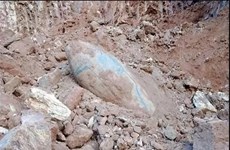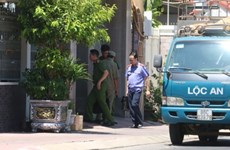Dong Nai province’s rural district gets well-deserved makeover
The creation of a new style rural area in Dinh Quan, one of the poorest districts in southern Dong Nai province, has helped develop infrastructure like roads and power supply, significantly improving the life of local people.
 A road has been cemented and beautified in Dinh Quan district’s Gia Canh commune, Dong Nai province.(Photo: VNA)
A road has been cemented and beautified in Dinh Quan district’s Gia Canh commune, Dong Nai province.(Photo: VNA)Dong Nai (VNS/VNA) - The creation of a new style rural area in Dinh Quan, one of the poorest districts in southern Dong Nai province, has helped develop infrastructure like roads and power supply, significantly improving the life of local people.
Under a national programme to build new style rural areas in the district, Dinh Quan has focused on building rural roads since 2011 to enable farmers to transport agricultural produce.
In the district's Phu Vinh commune, for instance, all rural roads have been cemented or asphalted. Roads linking hamlets in the commune have a width of seven metres though the programme only prescribes five metres.
Tran Thi Lan, who has a mango orchard in Phu Vinh's Suoi Son hamlet, said she had been able to sell her fruits at higher prices since the road running through the hamlet and to her orchard was cemented.
It used to be narrow, muddy and difficult to traverse and traders could not get there by truck, which pushed the mango prices down, she said.
"The cemented road helps residents travel easily and sell their agricultural products at a higher price."
The road was built using public funds and land donated by locals. Lan's family donated 3,000sq.m of land.
Thi Thi Anh Hong, Vice Chairwoman of the Phu Vinh Commune People's Committee, said local people also donated money and labour to build roads in the commune.
"On many roads, locals grow flowers and grass along pavements to beautify them."
The district has built or upgraded 717 roads with a combined length of 681km and cost of 1.15 trillion VND (49.57 million USD), according to its People's Committee.
With the development of road and other infrastructure facilities for agriculture, annual income from one hectare of farming land in the district increased to 145 million VND (6,240 USD) last year, 1.6 times the figure in 2011 before the programme started.
Tran Quang TU, Chairman of the Dinh Quang district People's Committee, said the focus of the programme had been on developing agriculture and improving incomes.
Besides support from the Government and provincial administration for developing agriculture, farmers and rural areas, the district also had its own policies to support farmers, he said.
They included helping farmers grow other high-value crops on low-yield rice fields, providing ethnic people with corn and rice seeds for cultivation and supplying power to concentrated farming areas, he said.
The district had developed fish farming based on Vietnamese good agricultural practice (VietGAP) standards to improve farmers' incomes.
Farmers were taught breeding techniques and treating wastewater from fish ponds.
Dang Hoang Long, who breeds snakehead fish to VietGAP standards in a 4,000sq.m pond in Phu Ngoc commune, said adopting VietGAP standards fetched higher yields and reduced costs such as for feed. Fish bred thus suffered from fewer diseases, he said.
"The income from breeding fish based on VietGAP standards is higher [compared to traditional farming methods]."
Dinh Quan has more than 865ha of aquaculture farms and an annual output of nearly 19,400 tonnes. A large number of farmers in the district breed fish in cages in the Tri An reservoir and the Dong Nai river.
Situated in the north-eastern gateway of the province, it is a mountainous district and has a large number of ethnic people.
The district has spent 21 trillion VND (904.9 million USD) on the new style rural area programme, with 3.12 trillion VND (132.8 million USD) coming from public funds and the rest from local residents and businesses, according to the district People's Committee.
The programme has significantly reduced the number of poor households in the district.
Its per capita income has increased to 50 million VND (2,150 USD), up 1.8 times from 2011.
In that period the number of poor households has reduced from 8,115 to 146, or a mere 0.32 percent of the total number.-VNS/VNA













